Large-fruited raspberries: the best varieties and agricultural technology
There is no such person who would not love raspberries. Anyone who claims that he did not like the ripe berry simply never tasted the ripe, self-picked fruit. Raspberries - has not only original taste, but also has healing properties. It is actively used for colds as an antipyretic agent.
Content:
The best varieties and their description
Summer is the time for a riot of colors, flowers and fruits. Fragrant raspberries are one of the first to bear fruit in the garden. It is not whimsical to the soil, it grows in any area.
Raspberries differ in the following types:
- Traditional - grows in any climatic zone, gives a good growth of young stock, bears fruit once a season. The berries are not very large. The harvest volumes are average. Outstanding representatives - Malakhovka, Shosha, Slastena, Magician, News Kuzmina.
- Repaired - loves abundant watering, bright sun, welcomes spring pruning. When leaving in the spring, a whole bush can be formed from one sprout. It responds positively to plucking the growth point, releasing side branches. The latter also form clusters. Produces two or three harvests, depending on weather conditions. It often happens that the second fruit ovary is richer in taste. Its distinctive feature is that before winter all shoots are completely cut off (Polyana, Morning Dew, Polka, Shugana, Golden Domes).
- Large-fruited - they are distinguished by a massive stem, abundant ovaries and large berries. Each of the juicy fruits can weigh up to 12-15 g. With good care, it is possible to harvest up to 10 kg from one shrub. The length of the vine can be up to 2 meters. For some varieties, it is necessary to make supports or drive in stakes nearby (Hercules, Hussar, Yellow Giant, Bryansk, Giant, Patricia, Taganka).
Often, large-fruited species are chosen among all varieties. The types of large-fruited raspberries most preferred by gardeners are distinguished:
- Patricia - the vine reaches a length of 1.8 m.The leaves are red-brown and large in size. There are no thorns on the trunk, which facilitates harvesting, which reaches up to 5 kg. The berries are very large, up to 12-14 grams, with a delicate velvety surface, oblong in appearance. It separates well from the stalk. After ripening, it does not crumble for a long time. Poorly tolerates transportation. With proper care, it can reproduce twice the yield.
- Giant - differs in large sizes up to 25 gr. With constant feeding and abundant watering, the bush is capable of producing up to 12 kg of fresh product per season. He is not afraid of frost and disease does not take him. The only disadvantage of the subspecies is that over time, the berries begin to lose in size, become smaller. It should be uprooted and replaced with new shoots.
- Hercules - ripens in late August - early September. It is characterized by long massive shoots (up to 2 m). Numerous sharp thorns are located on the stems. Berries are 5-10 grams each. each, of dense structure, tolerates transportation well. Productivity from one vine - up to 2 kg.
- Yellow Giant.The name speaks for itself - the product is yellow. The fruits are large, reaching up to 13 grams. in weight, formed on long stems up to 1.5 m in length. More than 8 kg of pure product can be removed. Excellent storage tolerance.
The presented subspecies adapt well to any soil conditions, easily tolerate frost and drought, and are practically not susceptible to pests.
Thus, if you want to plant a fruiting bush, you can choose not only by the ripening time, but also by the species and weight characteristics of the fruits.
Planting large raspberries
It is recommended to plant raspberries in open sunny areas, but on the condition that the plants will not be exposed to constant winds. Otherwise, there will be no results.
The planting site should not be between trees or among rows of vegetable crops.
Particularly undesirable is close proximity to tomatoes, potatoes or garden strawberries, they share pests that can migrate from crop to crop. Do not put in the old place where raspberries have grown before. Before planting on this site, it is required to let the soil “walk” for at least 5 years. It is advisable to plant legumes, mustard or rapeseed on this perimeter. Do not plant where water often stagnates. Prolonged stagnation of moisture is detrimental to the roots of the raspberry tree, they will rot.
In order for the plant to give bountiful harvests, the soil is required to be light, loose, airy, filled with minerals. If the soil is saturated with acidity, it should be fertilized with limestone before placing the raspberry tree. The latter is recommended to be added up to 0.5 kg per 1 m2. The main condition for good growth of shrubs and good yields is the absence of weeds, especially wheatgrass. They additionally suck out nutrients from the substrate, depleting it.
Agronomists have developed an algorithm for the necessary soil formation:
- A trench is dug up to 1.5 m wide, no more than 30 cm deep.
- Layers of peat soil, humus from stale leaves, old sawdust, compost... Ordinary garden soil must be poured between the layers.
- It is possible to add wood ash, as well as the introduction of mineral fertilizers in the form of a scattering of granules.
So that large-fruited varieties do not lose their original qualities, you need to be guided by some peculiarities of planting. You can plant it at any time - in autumn, spring and summer.
Before planting, the seedling must be shortened to 40-50 cm in height from the ground. The roots are thoroughly shaken off the ground and straightened in a new place. The stem must additionally be deepened by 3 cm. After that, water it abundantly and cover with sawdust or humus. Thus, although the plant is quite unpretentious, for abundant yield it is required to carefully select a place and carefully plant it on a prepared site.
Care Tips
Raspberries need watering, feeding, pruning and loosening. If you periodically carry out such events, then the shrub will not remain in debt and will delight you with delicious fruits:
- Watering should be done often, especially in the spring, when the shoots begin to wake up from hibernation, and the young are breaking out of the ground. Do not forget about irrigation on hot summer days.
- In the spring, you also need to take care of loosening the soil. The procedure requires more air and nutrients to reach the roots. As the soil becomes overgrown with weeds, they are weeded out, which is also a favorable moment for the growth and development of the bush.
- During the period of active growth, it is imperative to do top dressing. During the period of growth and fruiting, 2-3 dressings are usually done. The first is introduced in early spring. It needs to be prepared - chicken droppings, mixed with a spoonful of saltpeter, diluted in a bucket of water. It is recommended to apply nitrogen fertilizers - once a period, either in the spring or in the fall. After the harvest period, potash fertilization is required.Before flowering, you need to feed with a complex fertilizer - nitroammophos or Zdravn. This will allow a large number of buds to form.
Diseases and pests
To get neat, juicy berries that you will not be ashamed to put up for sale, preserve them whole, or just enjoy juicy fruits, you need to monitor the health of the shrub.
Although the plant is immune to diseases and pests, in the absence of care it can become infected and die.
Be sure to pay attention to the condition of the shoots and leaves. The following pests and pathogenic bacteria are distinguished:
- The raspberry beetle is an insect that hibernates in the ground. Their appearance was noticed in May. They are a small pest with gray oval shapes. The beetle initially eats flowers and leaves, and then moves inside the buds, eating them from the inside. After such an invasion, the berries sharply decrease in quantity, and the remaining ones are saturated with larvae.
- Kidney moth - a small butterfly with specks on its wings lays the larvae on the stems. The latter feed on the buds, eat away at the stem and penetrate inside, descending along it to the roots. Thus, injuring the entire plant from roots to buds, eating its contents.
- Stem fly - its activity begins in late May - early June. It lays eggs in the leaf axils, the hatched larvae eat their way to the center of the trunk, feeding on its core.
- Spider mite - weaves a web from the inside of the leaf, sucking all the juices from the greenery. The sheet dries out over time and falls off.
- Weevil is a beetle that lays offspring on buds. The larvae, feeding on the tender core, grow and increase the population of beetles.
- Chlorosis - the leaves become yellow, significantly deformed. It is required to make a top dressing complex fertilizers.
- Purple spot - appears on the leaves, accompanied by peeling of the upper layers of the stem. Shoots must be quickly cut and burned. Then spray with Bordeaux liquid.
When such pests as stem fly or kidney moth appear, the shoot expands in one place, forming a bump. The damaged sprout must be removed at the root, so that not even a hemp remains. Burn everything. At the beginning of the formation of buds, it is recommended to spray the bushes with a solution of tansy.
Thus, the main thing is to timely notice the emerging pests or diseases and apply methods to combat them.
More information can be found in the video:



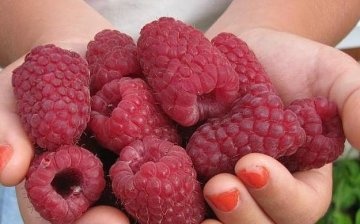
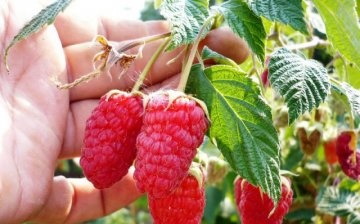
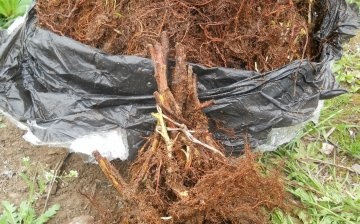
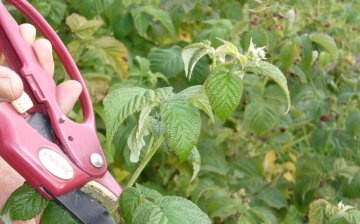
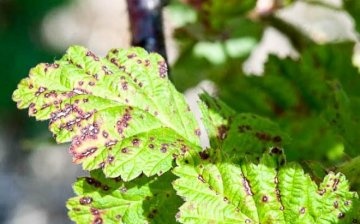






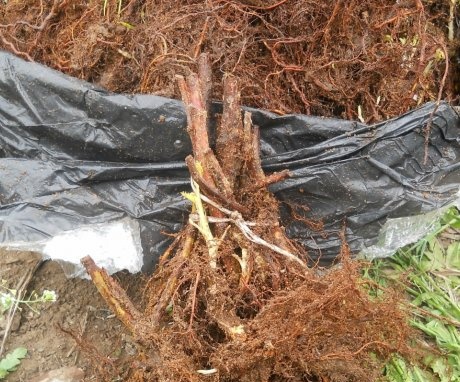
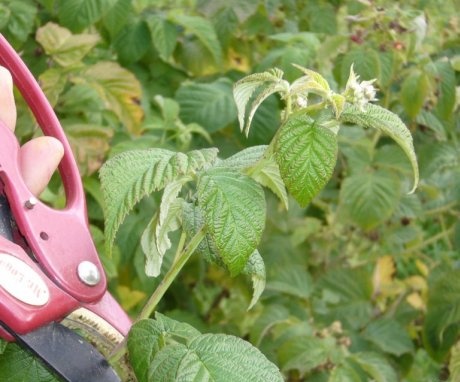
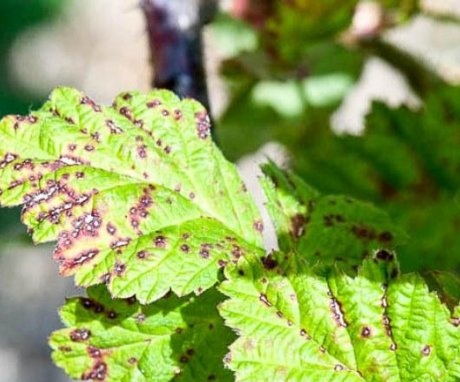
My daughter-in-law has such a raspberry. She admires her very much, but I am not very enthusiastic about her. Our most ordinary raspberries are much tastier and smell more fragrant. This one looks like plastic, beautiful, but there is no taste ...